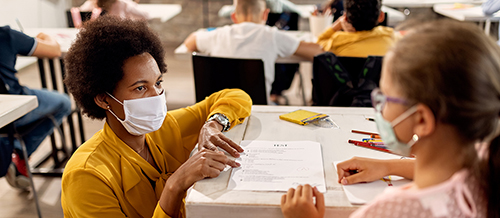
Social workers can learn how to incorporate safety and connection when working with children and youth who may be experiencing difficulties brought on by the COVID-19 pandemic.
Kashera Guy Robinson, LCSW, and Uraina L. Scott, LCSW, school social workers in the Atlanta area, present the NASW Special Practice Sections webinar, How social workers can help students learn to thrive and heal in the midst of an international public health crisis, available at the Social Work Online CE Institute.
It’s important to use regular check-ins with assigned students, Robinson stresses. “For my high schoolers, we have issues with kids not coming into school,” she says. “What we have seen since the pandemic are students having even more issues with absenteeism.”
But there are techniques to address this. You can have students check in with you at an assigned time and location, for example. Since most students love technology, putting a QR code on your door allows students to stop by and scan the code. The code can be programmed for the social worker to be alerted that a student has checked in or needs to see you.
Having a safe place to meet and identifying supportive adults is also important for students, Robinson points out. Social workers can help students find supportive adults in the school, such as teachers, counselors, and other school social workers.
We help them identify who they can go to when they are having a difficult time outside of school as well, such as a parent, neighbor or a trusted friend, Robinson adds. It’s also a good idea for social worker to participate in school, district, and community meetings such as school board meetings, PTA meetings and stop the violence rallies.
Another approach with children in school settings is brief solution focused counseling, which highlights the student’s strengths and solutions, not the deficits or the origin of the problem.
In using this approach, the student—not the social worker—devises the goals and solutions, Robinson says.
Social emotional learning is encouraged as well. It has the tenets of self-management, self-awareness, responsible decision-making, relationship skills, and social awareness. Helping children and youth cope with challenges includes activities such as dancing, drawing, painting, music, nature, and writing.
Your voice tone is important, Scott notes. Talking calmly helps children and youth feel they are in a safe place. For school social workers with their own space, room configuration that promotes a welcoming environment also is encouraged. Colored light bulbs, for example, can provide a soothing environment, Scott explains.
It’s also a good idea to make sure children have a choice in what materials and media they want to use to express themselves.
Scott urges social workers to model the behavior they want their young clients to convey.
“What you want to do is help them see, ‘Oh, it feels good to receive that type of care,’ so that they will hopefully model that type of care with their peers,” she says.
She even provides a guided meditation in the webinar. She asks participants to rate their anxiety level before and after the mediation. “That number should be lower than when we started,” she says after the meditation.
There are many guided meditations and resources that participants can reference in the webinar.
Music can also aid social workers in several ways. For example, some beats can impact moods and productivity, Scott says. You can use music in a way that the child likes to show how they feel. It can be used as a way to connect, she says.
Webinar Focuses on Young Adults of Color on the Autism Spectrum
The NASW SPS webinar, Equipping Social Workers to Meet the Needs of Young Adults of Color on the Autism Spectrum, introduces participants to research and techniques for social workers to use when serving young adults of color on the autism spectrum.
The webinar’s focus is on working with college students. However, many of the suggestions will be applicable to adolescents in school settings. The learning objectives include:
- Introduce research about the experiences of young adults of color on the Autism Spectrum.
- Understand ways for social workers to apply research-based techniques to help young adults
- Learn about the evidence supporting the effectiveness of these techniques and the need for additional research.